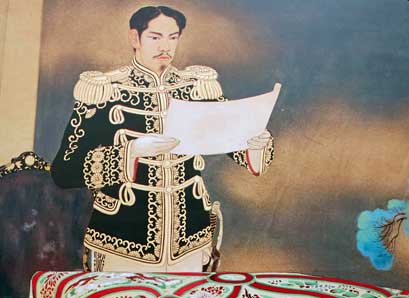The Emperor Meiji in Western Military Attire.
A palace coup of 1868, which overthrew the Tokugawa Shogunate and “restored” power to the Japanese emperor, followed by the rapid socioeconomic and political changes that occurred during the reign of the Meiji emperor from 1868 to 1912. In 1868, a coup led by disgruntled nobles toppled the enfeebled Tokugawa Shogunate that had ruled Japan since the feudal era, shifted power to the emperor, and moved the imperial court from Kyoto to Tokyo. The political revolution of 1868 vested de jure sovereignty in the emperor, but de facto power was wielded by the genro, an oligarchy of nobles and former samurai. The new Meiji government governed a militarily weak and economically backward nation threatened by Western encroachment, and under the banner of fukoku Kyohei— a rich nation, and a strong military—embarked on a series of reforms that radically transformed and modernized Japanese society.
The Meiji government abolished feudalism, made large investments in modern infrastructure and industries, and introduced a national education system. The government dispatched Japanese students overseas to study the latest aspects of Western science and technology, and foreign experts were hired to teach in Japan. Military modernization was a key goal of the Meiji government, and a conscript national army based on the Prussian model and a modern navy based on the British Royal Navy were established. In 1877, the government used the army, trained in modern European infantry tactics and equipped with the latest weaponry, to quell the Satsuma Rebellion and destroy the last vestige of Samurai resistance to the Meiji reforms. The Meiji Constitution, based on the Prussian constitution, was drafted by Hirobumi Itō and adopted in 1889. Elections for the first diet were held in 1890, but suffrage was limited to the wealthiest 1 percent of the population. In the later Meiji period, Japan triumphed in the Sino-Japanese War and Russo-Japanese War, negotiated an alliance with Britain, and abolished the unequal treaties with the Western powers. By the end of the Meiji period, Japan was counted among the ranks of the Great Powers. See also Anglo-Japanese Alliance; Chrysanthemum Throne; Japanese Empire.
Itō, Hirobumi (1841–1909)
The preeminent Japanese statesman of the Meiji period, Hirobumi Itō served as prime minister on four occasions (1885–1888, 1892–1896, 1898, 1900–1901). While studying in Europe as a young man, Itō became convinced of the need for Japan to abandon its insularity and modernize. Returning to Japan, Itō was instrumental in establishing the political institutions of the Meiji Restoration. From 1883 to 1889, he supervised the drafting of Japan’s first constitution. In 1885, he created a modern civil service, established a cabinet and became the first prime minister of the Japanese empire. Itō supported the Sino-Japanese War and negotiated the Treaty of Shimonoseki, but subsequently failed to negotiate a peaceful settlement with Russia.
In 1906, he was appointed resident-general in Korea. In 1909, Itō was assassinated by a Korean nationalist while visiting Manchuria, and the military used the pretext of his death to annex Korea to the empire. See also Japanese Empire; Russian Empire.
Mutsuhito, Emperor of Japan (1852–1912)
The emperor who presided over the transformation of Japan from a feudal realm into a modern nation and empire. Known posthumously as the Meiji Emperor, Mutsuhito assumed the crown in 1867 and became the preeminent symbol of the dramatic changes and extraordinary accomplishments still associated with the era of “enlightened rule” of the Meiji Restoration: national unity, modernization, industrialization, military victory over China and Russia, and empire in Southern Manchuria, Korea, and Taiwan.
Although an imposing figure of stocky build, bushy brow, and calculated reticence, the Meiji Emperor, unlike European monarchs in the Age of Absolutism or even the German Kaiser on which the modern Japanese imperial institution was modeled, wielded primarily symbolic power. Emperors had theoretically reigned in Japan from 660 B.C ., but from the twelfth through early nineteenth centuries, the most powerful warriors, samurai, in the land had actually ruled. Mutsuhito and his courtiers were living in obscurity in Kyoto, the traditional capital of the imperial family, when suddenly plucked to serve as the central symbol of a modern nation.
The “restoration” of authority to the emperor was a convenient pretext for the dramatic overthrow of the warrior family that had ruled Japan for more than 250 years, the Tokugawa. A boy of only 15 in 1867, Mutsuhito was useful not only in conferring political legitimacy on the young samurai usurpers of power but ultimately in fashioning an entirely new national polity. The founders of modern Japan painstakingly transformed the imperial institution into the central symbol of a modern nation and empire. All political, diplomatic, social, and economic reforms were promulgated in the emperor’s name. The Meiji constitution of 1889 described the emperor as “sacred and inviolable” and placed all executive, legislative, and judicial powers in his hands.
Although the samurai founders of modern Japan actually ruled in their capacity as imperial “advisers,” Mutsuhito became the official face of Imperial Japan. First introduced to his subjects in a series of six Grand Circuits between 1872 and 1885, Mutsuhito’s symbolic presence grew enormously during the Sino-Japanese and Russo-Japanese Wars. He was described as enduring the privations of a soldier at war and portrayed as the heroic and caring commander-in-chief in woodblock prints, war songs, and magic lantern shows. Mutsuhito’s death in July 1912 spurred deep and widespread mourning and ushered in a period of wrenching national uncertainty.
